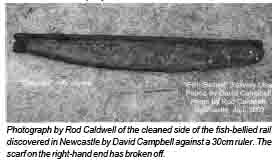
Australia’s First Railway – rare relic
The Light Railways magazine issue 197, October 2007 reports on the latest research in verifying the source of the piece of fish-bellied rail uncovered at Newcastle.

The discovery of an original fish-bellied rail from the 1831 Australian Agricultural Company colliery tramway has generated considerable interest from readers.
Colleagues from the Newcastle Industrial Heritage Association have provided additional information about this important discovery.
Rod Caldwell advises that the relic was found within a few metres of where the rails would have been laid for the AA Company 'C Pit mine and it is believed that the rails from the 1831 tramway were used for the incline there.
Bob Cook advised us that he visited the Science Museum and the National Railway Museum in England during June 2007 where he observed various types of early cast iron rails and from this he concluded that the rail found at Newcastle (NSW) is similar to the types used in England prior to 1830.
For further clarification, we approached English historians who specialise in early permanent way and the rails used for these, via Grahame Boyes. Grahame circulated his group and advised the information about the Newcastle rail discovery had been received 'with considerable excitement.
Michael Lewis, the author of Early Wooden Railways, has provided a detailed response. He described the AA Company rail as an "extraordinary find" and concluded: 'there's not a shadow of doubt that your rail is a rail, and its design is entirely in keeping with a date of 1826.' A subject of some contention was the scarfed or overlapping method of joining the rails. Michael notes that the most common method scarfing was the one patented by Losh and Stephenson in 1816, but by a decade later a variety of other methods were being tried. He advises that a specimen rather similar to the one found at Newcastle (NSW) had been on display in the Newcastle Museum of Science and Industry (UK). It was 4ft long with a vertical rib near each end to locate it in the chair, and it ended in a semicircular male lug to fit a corresponding female socket in the next rail. Thus, it seems highly plausible that the rails sent to Newcastle NSW in 1827 should have been supplied from, or at least designed at, Newcastle UK. The old Newcastle Museum closed years ago and its holdings went to the new Discovery Museum in Newcastle. Contact has been made with the curator at Discovery, who has offered to assist with establishing the provenance of the AA Company rail.
Research on this important railway relic continues.
Thanks to Bob McKillop – Editor, Light Railways for the above article.
Newcastle Industrial Heritage Association
http://www.niha.org.au/article.php/20071004223829212